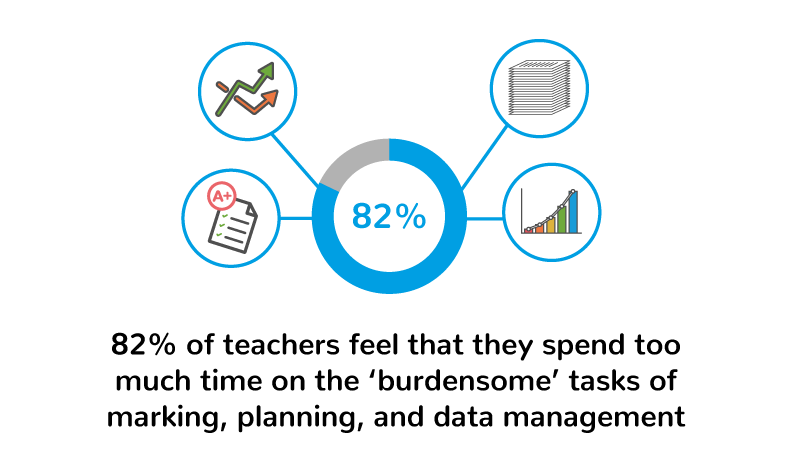In brief
- Internationally, teachers are overworked. Only 8% have been adequately exposed to the potential of thoughtfully designed technology to transform their working conditions.
- In the UK, technology-enabled virtual tutoring could save teachers 7 hours each week, and free up a further 13 hours to re-allocate to aspects of their job where their human impact is the greatest.
- Taking steps to embed virtual tutoring within the classroom would represent a systemic change designed to allow every child to achieve educational outcomes in the long-term without running teachers into the ground.
In his essay ‘In Praise of Idleness’, the 20th century philosopher Bertrand Russell idealised a state that shared the factory work of a number of overworked men with a litany of underworked men to create general workload satisfaction. According to Russell, splitting the load would gain each man a further set of elastic hours to be applied to society-furthering projects as part of a sustainable working culture. The analogy is imperfect given the one-dimensionality of manufacturing metal pins and the proposed employment of more humans, but the logic for allowing technology to take some of the strain of teaching is the same.
The (neglected) time-saving potential of technology
Across the world, teachers are overworked and overburdened. In the UK, 70% of primary school teachers and 76% of secondary school teachers acknowledge that they cannot complete their work within the contracted working day, while an estimated 325 million hours of their labour goes unpaid and unacknowledged annually. Most of us accept that teachers hold a comparable role and responsibility to parents (though voluntary) in raising healthy, happy children and promoting the lifelong learning that will transform the world of the future. Nevertheless, reforms to date have failed to wrestle teachers workloads under control in order to prevent high rates of burnout, extended teacher absences, or a continued mass exodus from the profession in some countries.

In 2016, the Education Policy Institute (EPI) found that teachers who employed technology during most or all of their classroom hours worked on average 4.6 hours less than their tech-free counterparts each week. In the same year, only 8% of teachers cited technology, unprompted, as their envisaged way to shorten the working day. Information about the potential for technology to assure educational outcomes within a reduced number of hours languishes in research papers. This insight is unbeknown to the teachers for whom smart technology could facilitate the evergreen goal of working smarter, not harder.
Here’s how virtual tutors save, regain, or maximise every hour that teachers lend to the profession…
1. Saved: Fewer hours spent
It is claimed repeatedly and with confidence that AI-powered learning platforms will save a secondary school teacher 6 hours a week, equivalent to one hour, per class, per week by eradicating the need for marking and data collection, shortening planning time, and occupying students for a reduced amount of instructional time. In such statements, productivity – the ability to achieve the same results in less time through an increased rate of output – is lauded as the key benefit of technology.
Technology-enabled virtual tutors do help teachers to work fewer hours. They release teachers from the time-consuming, repetitive, and famously unfulfilling elements of their day by automating those tasks which do not capitalise upon the unique skillset of a teacher. 82% of teachers feel that they spend too much time on the ‘burdensome’ tasks of marking, planning, and data management, but these areas are the virtual tutor’s forte. Virtual tutors continually assess students’ strengths, weaknesses, attainment, and progress and produce data summaries as a by-product of learning.
On average, virtual tutors could save secondary school teachers 6.3 hours of marking, 4.8 hours of data inputting, an hour or so in finding ways to communicate information to parents, and any time they spend compiling assessment activities and papers for accountability purposes each week.

Clearly presented data across the class and for each, individual student on specific learning objectives allows teachers to select an appropriate focus for the next lesson at a glance. Collections of resources which are ready to deploy, such as the 1, 200 interactive lessons held in the Maths-Whizz Teachers Resource area, further cut down on the 7.3 hours typically spent on lesson planning and searching for material.
Virtual tutors can also limit the hours of intense, in-person instruction required. A Whizz Education case study indicated that after an hour with a virtual tutor, only 15 minutes of human tuition was needed to achieve 5 months of progress through the curriculum over 12 weeks. Following this model, school teachers who teach for 19.9 hours a week distributed across, say, six classes could save around half of their hours spent on highly-supervised teaching without sacrificing progress, although teachers are unlikely to adopt this approach.
With quality assured virtual tutoring products embedded into classroom routine, teachers could achieve comparable outcomes with 20-30 fewer hours of human input. But this value reflects the misguided belief that productivity is a teacher’s sole concern.
2. Regained: Time better spent
As well as reducing the overall length of the working day, virtual tutors allow teachers to spend a greater proportion of their day focused on the aspects of their job where they can make the most difference. The true selling point of learning technologies is not that they increase the speed at which teaching is delivered. Rather, because they allow for the optimum delegation and prioritisation of tasks, they maximise the value a teacher can add to every school hour.
McKinsey’s model of AI’s capacity to free time for ‘re-allocation’ better mirrors the sense that a teacher’s time will continue to be absorbed by one of a diverse and ever-expanding repertoire of possible tasks, including by the hours of direct instruction which feature so strongly in typical visions of a how a teacher spends their day.
The company’s prediction that AI teaching technologies can save 13 hours of a teacher’s time understands that these hours are both saved and ‘regained’ to be spent on inspiring, motivating, communicating, and innovating rather than data processing.
Issues with workload stem primarily from the number of hours, but also from a dissatisfaction with how limited hours are spent. It is demoralising to have one’s professional skills wasted on administrative tasks but empowering to have them re-directed towards helping children to fulfil their potential. We might then claim an average of 7 hours saved and 13 hours regained.
3. Maximised: Value Added per unit of time
Taking the argument along its natural progression, virtual tutors have the potential to make every working hour less stressful, more valuable, and more fulfilling for teachers.
Virtual tutors can guarantee learning outcomes. With Maths-Whizz, children progress an average of 18 months in their first year with just 60 minutes of use a week. If virtual tutors can consistently accelerate learning, the pressure on teachers reduces and every hour of teaching time becomes supplemental. Where 23% of students do not reach baseline achievement in OECD countries, the difference this security makes should not be underestimated.

An hour of individualised attention for every child, in every subject, each week has the potential to combat summer learning loss and close the multi-year learning gap, resulting in less heterogeneous classrooms. Permanent access to personalised instruction which identifies and fills knowledge gaps renders classroom lessons accessible to an increasingly greater percentage of the class overtime and lesson plans need not be differentiated to such an extent.
Finally, freed time spent on teacher’s Career Progress Development (CPD) will increase teacher capacity, allow them to generate inventive solutions, best serve their students, and tackle their workloads efficiently. Currently, 60% of teachers quote their workload as a barrier to CPD.
Our claim extends further still: 7 hours are saved, 13 hours regained, and whole days maximised.
Significantly, these figures relate to the hours worked by secondary school teachers whose teaching is specialised. For primary school teachers who grapple with the full range of subjects, including those outside of their area of expertise, the time-saving potential is even greater.
Forward-thinking policy and accumulative, long-term change
Only a small fraction of the world is ready and equipped to make full use of the potential of virtual tutoring to save teachers’ time. In many contexts, getting to a place where virtual tutors can be effectively implemented will itself necessitate a time commitment.
Developing technological infrastructure, increasing internet connectivity, and prioritising education are key aims of the UN Sustainable Development Goals and are increasingly on government agendas.
At a cost of around £5 a week, virtual tutors within the classroom should be a goal to strive towards if we value teachers. Affordable, educationally-effective tools that have been proven to reduce workload in classrooms from rural Kenya to the UK, US, and New Zealand must become the norm rather than the exception.
Where teachers lack the time and energy, this agenda should be pushed by politicians already armed with the numbers, especially now that technology is advanced and affordable and the COVID-19 pandemic has necessitated innovative delivery models.
